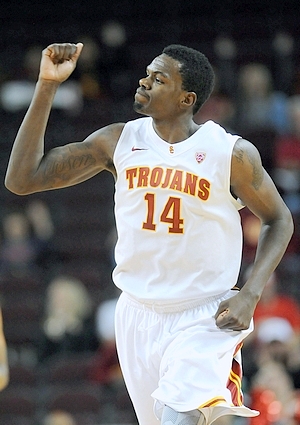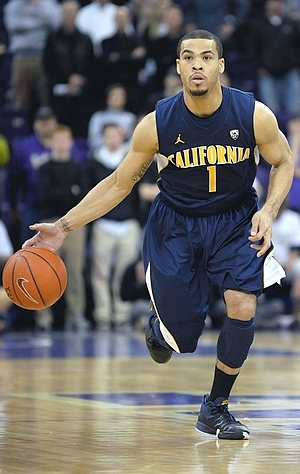Incoming freshmen have been excluded from these previews, as we'd like to wait and see what they have to offer on the NCAA level before we come to any long-term conclusions.
-Top 20 NBA Prospects in the Big Ten
-Top 20 NBA Prospects in the ACC
-Top 11 NBA Prospects in the Big XII
-Top NBA Draft Prospects in the Pac-12, Part One, #1-5
(#1) Andre Roberson
(#2) Joshua Smith
(#3) C.J. Wilcox
(#4) Devon Collier
(#5) Allen Crabbe
-Top NBA Draft Prospects in the Pac-12, Part Two, #6-10
(#6) Eric Moreland
(#7) Brock Motum
(#8) Chasson Randle
(#9) Mark Lyons
(#10) Travis Wear
-Top NBA Draft Prospects in the Pac-12, Part Three
(#11) Solomon Hill (Video Scouting Report)
#12 Dewayne Dedmon, 6-10, Junior, Center, USC

Jonathan Givony
One of the more unique stories in college basketball, Dewayne Dedmon didn't start playing the game until four years ago, a gangly 18 year old Jehovah's Witnesses. He played just one season at Antelope Valley Junior College and then sat the following year in order to preserve three seasons of eligibility at USC. Unfortunately he was only able to play 20 games last year before tearing a ligament in his knee and being forced to sit out the rest of the season.
Dedmon's intrigue as a prospect is readily noticeable on first glance, standing seven feet tall, with an excellent frame and a long wingspan. He's also extremely mobile for a player his size, running the floor exceptionally well, and being quick off his feet, highly agile and very explosive around the rim. Simply put, players with his physical attributes are extremely rare, and typically highly coveted.
Dedmon played for one of the worst teams in college basketball last season, a USC squad that went 1-17 in a very weak Pac-12 conference, and sported the least efficient offense in high major basketball. That surely didn't do him any favors considering it was basically his first real season of playing organized basketball, but that did probably allow him more opportunity to figure things out as the year moved on, which he certainly appeared to do.
Playing 23 minutes per game, he didn't have the skill-level or experience needed to be much of focal point for USC offensively, as he struggles to create shots for himself. While clearly being strong enough to establish position inside the paint, Dedmon possesses a very rudimentary post game, as he shows little in the ways of footwork, counter moves or a left hand. He does have good quickness on his initial moves, but can be defended fairly easily in one on one situations, as he's an extremely poor passer (dishing out just 6 assists in 465 minutes last season) and rarely gets to the free throw line.
Where Dedmon shines is as a finisher around the basket, converting nearly 75% of his looks at the rim last season, one of the highest rates in college basketball. He's nearly automatic when catching the ball in space due to his tremendous physical attributes, something that his team wasn't always able to take advantage with their extremely weak backcourt.
Dedmon is a terrific offensive rebounder, best in the Pac-12 on a per-minute basis, thanks to his terrific agility, leaping ability and wingspan.
As the year moved on, Dedmon's comfort level offensively seemed to grow somewhat, even making a couple of face-up jumpers from 10-12 feet. His shooting mechanics look decent, even if the 54% he shot from the free throw line shows that he still has a long ways to go in this area.
Defensively, Dedmon has everything needed to be a real game changer in time, as his combination of mobility, length and strength at 7-feet tall is extremely rare. He moves his feet very well for a player his size, showing very good potential hedging screens on the perimeter and recovering quickly into the paint, being very difficult to shoot over. He showed potential as a shot-blocker, but wasn't too prolific in this area, only rejecting four shots in just over 7 games in Pac-12 play.
His strong frame makes him tough to post up very effectively inside the paint, even if he clearly doesn't have very much experience guarding other players his size, and is still a bit naïve biting on pump fakes. Dedmon averaged 5.5 fouls per-40 minutes last season, which made it difficult for him to stay on the court at times. He's also a surprisingly poor defensive rebounder, second worst amongst centers in our top-100, something scouts will undoubtedly want to see him improve on this season.
All in all, Dedmon certainly looks like the part of someone who hasn't been basketball very long, which will make it interesting to see how he progresses this season with a little more experience underneath his belt. If he's able to show the type of learning curve you'd expect from a player with his experience-level, he could certainly draw quite a bit of NBA interest considering his tremendous tools, despite turning 23 a few months ago. 27-year old Bernard James proved last year that NBA teams aren't afraid to roll the dice on older guys with rare physical attributes that are relatively new to the game.
#13, Tony Woods, 6'11, Center, Senior, Oregon

Kyle Nelson
Tony Woods has had a turbulent college career, leaving behind a promising career at Wake Forest after he pled guilty to assault. Two of the charges were dropped and Woods assumed full responsibility for the incident, but he nonetheless sought to transfer and was granted a letter of release. He eventually landed at Oregon, where he rebounded to help lead the Ducks to an NIT run. Now, a senior, Woods has the opportunity to live up to his reputation as a top-50 recruit in high school while helping the resurgent Ducks return to the NCAA tournament.
Woods possesses an elite physical and athletic profile for the center position, standing 6'11 in shoes with an excellent 250 pound frame and a 7'2.5 wingspan. Though he moves awkwardly at times, he is very strong and runs the floor well, showing solid lateral quickness for his size, and being capable of playing above the rim with ease. He certainly looks the part of an NBA center and will likely get extended looks at the professional level based on his physical attributes alone.
The problem is, however, that Woods hasn't improved much since his sophomore year. Never a particularly productive player, Woods averaged just 6.8 points per game and 14.8 points per 40 minutes pace. While this isn't necessarily bad Woods saw his shooting percentage drop significantly from an excellent 60.8% to 53.1%.
His lack of productivity is particularly problematic on film as he displays a very low skill level and awareness. Woods is still not much of a post-up threat and, though he can carve space out the block and can finish emphatically, he struggles to create shots for himself due to his raw footwork. Many of his 3.1 turnovers per game are travels and offensive fouls with his back to the basket. Similarly, his jump hook - his most reliable post move - is less effective because he tosses the ball at the basket with little follow through while showing a general lack of shooting touch. Synergy's Shot Attempt Breakdown is telling, therefore, as he sees nearly half of his shots while posting-up and makes only 41.4% of his attempts.
Where Woods remains effective, however, is as a finisher around the basket, typically off alley oops, offensive rebounds, cuts, and transition opportunities. He made an astounding 74.2% of these attempts and exploited his elite size and athleticism to his advantage. Once he gets off the ground, it is very hard to stop him and he draws plenty of fouls powering his way to the hoop. He was not as active on the boards as a junior, however, pulling down an exceptionally poor 4.7 defensive rebounds per-40 pace adjusted. This is particularly concerning at this stage in his development and considering his legitimate physical advantages at this level.
Woods has improved marginally as a shooter, as well, elevating his FT% to 58.1% from 48.1%, but is still limited by his lack of shooting touch. He continued to show flashes of spot-up shooting ability, but the results were mixed as he made just 27% of his 11 attempts while showing poor mechanics and lacking the necessary follow through in his release.
If there is one area in which Woods could possibly contribute at an NBA level, it's on defense. He continues to show promise while defending the rim, demonstrating improved instincts alongside his natural combination of length, size, explosiveness, and lateral quickness. He ranks as one of the NCAA's top returning shot blockers in our database, at 3.5 blocks per 40 minutes pace adjusted. As we wrote in the past, he holds his ground very well and does a solid job of using his body to prevent his man from getting to the basket. Also worth pointing out is that he looks more active stepping out and guarding opponents on the perimeter, even if his awareness on the pick-and-roll leaves much to be desired.
Turning 23 this January, scouts will be watching to see if he can further develop on both ends of the floor, particularly while showing renewed focus crashing the boards. After all, he has looked the part of an NBA center since he was a teenager. Furthermore, he'll have to prove to decision makers that [url=]his off-court issues are in the past.
That being said, there is a lot to like about Woods as a prospect in terms of his physical profile and defensive potential, and his senior year will be very telling for his NBA potential. Unlike last season, he has had a full off-season to recover from injuries and train with Oregon's coaching staff. A solid senior year and a strong showing at Portsmouth could help prove to NBA teams that he's worthy of a roster spot.
#14, Abdul Gaddy, 6'3, Senior, Point Guard, Washington

Matt Williams
Last time we checked in on Abdul Gaddy, he was coming off a difficult freshman season that saw him struggle for long stretches. Tearing his ACL just 13 games into his sophomore year, Gaddy bounced back to some degree as a junior playing alongside NBA first round picks Tony Wroten and Terrence Ross. The former McDonald's All-American emerged as a reliable floor general as the year progressed, though he remains limited as a scorer. The 20 year-old senior will have ample opportunities to show improvement this season, as he'll be asked to take his game to the next level.
Standing 6'3, Gaddy has good size for the point guard position at any level, but is a limited athlete by NBA standards. He was never extremely explosive, known more for his ability to change speeds and dictate tempo to get to where he wanted to go on the court early in his career, and the knee injury he suffered as a sophomore certainly did not help him in that regard.
Lacking blow-by quickness, Gaddy still finds ways to distort defenses and make plays as a passer, using simple changes of speed and hesitation moves to catch his defender off guard one-on-one and get into the lane before looking for the open man. A crafty, pass-first floor general with solid ball-handling ability, the Washington native has tremendous court vision, improving his decision making significantly since his freshman year, and runs the pick and roll very effectively. Ranking among the top-30 or so players in the country in pure point rating, Gaddy is a fine facilitator, which is certainly a coveted trait at the professional level.
As a scorer, Gaddy is not nearly as effective or efficient. Shooting 44% from 2-point range and 33% from beyond the arc, Gaddy can be described as a reluctant scorer, attempting the sixth highest percentage of shots on his team, despite playing by far the most minutes. He shot a very respectable 55% at the rim last season according to Synergy Sports Technology, but doesn't have the quickness to create easy opportunities for himself at the basket, and is often held back by passivity, looking reluctant to take charge on offense.
Some 62% of Gaddy's field goal attempts are jump shots, of which he makes a meager 28% off the catch and 33% of the dribble. As we noted in our last report, if Gaddy is going to reach his potential, he'll need to make significant improvements as a shooter to compensate for his lack of slashing ability. He looked comfortable from the three-point line at times last season, but finishing the season averaging just 9.0 points per-40 minutes pace adjusted is as much a reflection of Gaddy's pass-first tendencies as his limited shot-making ability.
Defensively, Gaddy plays with very good intensity. He doesn't have elite lateral quickness, but makes the most of the tools he does have, getting in a stance and working hard to deny dribble penetration. He knows his limitations and leaves himself a cushion against quicker players, but always gets a hand up when his man pulls up.
The youngest senior in the country, the Huskies will be Gaddy's team this season. If he can show progress as a scorer and continue to distribute the ball at a high level, he could rank among the best passers in the senior class at year's end. He's not a glamorous NBA prospect, and certainly has his limitations, but his high basketball IQ and willingness to compete on every possession certainly help his cause.
#15, Justin Cobbs, 6'3, Junior, Point Guard, California

Derek Bodner
After transferring from Minnesota at the completion of his freshman season, Justin Cobbs worked his way into the starting lineup early in his California career, forming a very dynamic back court with running mate Jorge Gutierrez. Standing 6'3" with long arms, Cobbs has good size to play the point guard position, where Cobbs well rounded game allows him to be both a facilitator and a scorer at the collegiate level.
The first place where you can notice Cobbs ability is in transition. While just an average leaper, Cobbs has solid quickness with the ball in his hands and does a good job pushing the tempo in transition.
In the half-court, Cobbs is most comfortable in pick and roll sets, which made up nearly 30% of his offense last year according to Synergy Sports Technology. Cobbs is effective both as a shooter off the pick and roll and using that edge to get into the paint. He has good body control and touch inside the paint, but can struggle to finish against taller defenders. He compensates for that with an assortment of floaters and pull-up jumpers that make him tough to defend in these sets.
Overall, Cobbs is a diversified shooter, showing the ability to make shots with his feet set and off the dribble. While not a high volume three point shooter, Cobbs has range beyond the collegiate three point line and is also comfortable in mid-range, usually the product of pull-up jumper shots from after getting by the initial layer of defense on the perimeter. His form and balance can sometimes stray on these pull-up shots, but his overall above average touch allows him to maintain some level of consistency.
Cobbs shows the same potential, and limitations, in isolation as he does in pick and rolls, with a solid first step and quickness hampered somewhat by struggles to finish around the basket, and compensated with a solid assortment of floaters and pull-up jumpers. A willing passer who overall maintains a good turnover rate, Cobbs can at times get turnover prone with over-aggressive forays into the paint.
Cobbs is a willing passer who does a good job of keeping his eyes open for his teammates, particularly off of pick and roll sets when the defense is slow to react. While not the most creative passer or showing the best court vision, Cobbs does a good job of moving the ball quickly and making the simple pass to keep an offense moving.
Defensively, Cobbs shows good potential with his combination of strength, length, and ability to move his feet. He's at home as a pressure defender, as he likes to pick up his man far from the hoop, doing a good job of getting opposing point guards out of rhythm. He can struggle at times drifting off his man to help off the ball, and his stance and technique can sometimes break down, but his overall effort level and physical tools gives him solid potential as a defender down the line, particularly if defending his natural point guard spot. His size would be a detriment if asked to defend shooting guards for extended periods of time at the next level.
The biggest question for Cobbs going forward may be what role he would be suited for at the next level. An overall well rounded player, Cobbs hasn't shown truly elite ability in any one area, either as a scorer or distributor, putting into question exactly what role decision makers can bank on him fulfilling at the next level.
After sitting out the 2010-2011 season due to transfer rules Cobbs was a pleasant surprise for the Golden Bears, moving into a starting role for them early in the season and helping them to a 24-10 record. With the graduation of Jorge Gutierrez, Cobbs will likely have to take assume a larger role than before in his junior year, and how well he responds will likely have a significant impact on his draft stock over the next two seasons.




































Comments